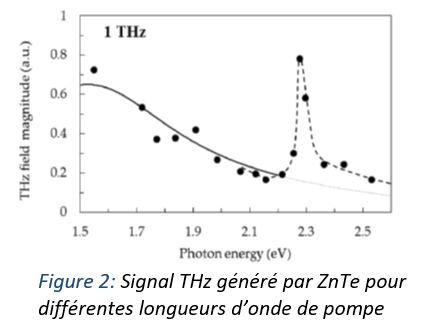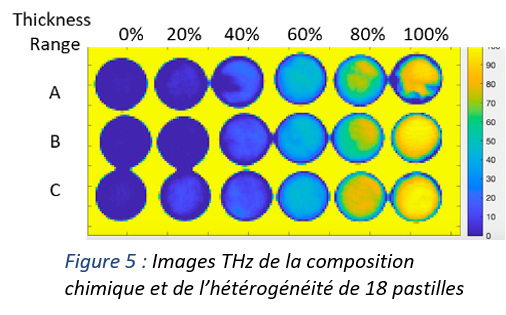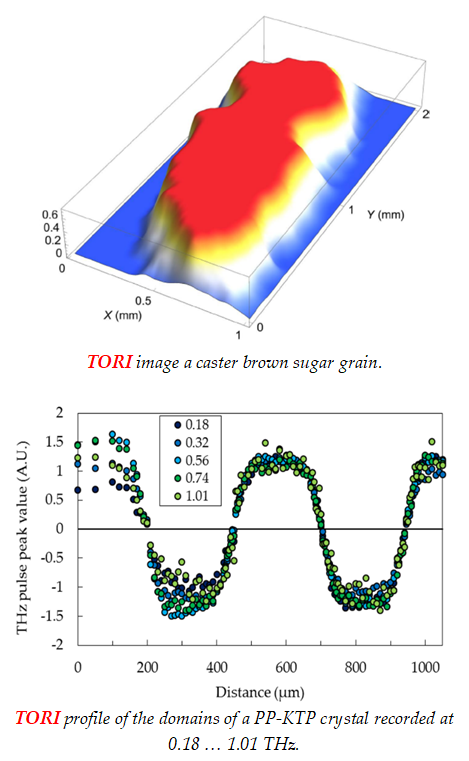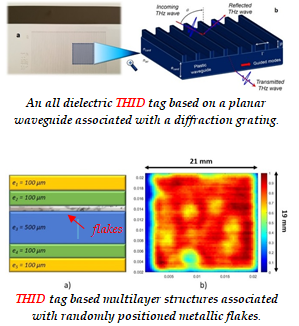Contact
Contexte et objectifs
Ce thème est décliné en trois sous-thèmes dont nous présentons les principales avancées et résultats de la période 2019- 2024. Il s’appuie sur la plateforme PLATERA que certains de ces résultats scientifiques contribuent à développer afin de conserver une expertise au meilleur niveau national et international.
Trois activités sont développées au sein du thème :
- Générations et détection THz
-
L’objectif est de développer des composants ou des techniques pour de futures applications THz comme la spectroscopie, la caractérisation structurelle ou l’électronique à très hautes fréquences et notamment l’électronique quantique. Deux approches sont envisagées : les composants optoélectroniques rapides et les effets d’optique non-linéaire pour la génération et la détection de signaux THz.
Dans le cadre d’une collaboration avec l’Institut Néel (projets QTERA, STEPFORQUBITS et EQUBITFLY), nous développons des circuits
THz intégrés pour des applications à l’électronique quantique. Ces circuits intègrent une ligne coplanaire et des photocommutateurs rapides (PCS) de génération et de détection de signaux impulsionnels THz. L’Université de Bochum fourni les couches de GaAs épitaxiées à basse température, les dispositifs fabriqués à l’institut Néel, sont conçus et caractérisés à CROMA. Les applications à l’excitation et au contrôle de Qubit électroniques sont faites à Néel. Nous étudions également des PCS à fort rendement de conversion optique- THz, pour générer des impulsions ps de 100 mV avec une énergie laser limitée à 1 pJ ce qui permettrait de maintenir la T° des circuits quantiques en deçà de 0.4 K. Les composants (3D) sont constitués de réseaux de piliers de GaAs de 100 nm de côté et 300 nm de haut (cf. Figure 1). Les simulations montrent qu’ils sont un ordre de grandeur plus efficaces que les composants 2D « standards ».
Une autre application de la génération THz est de considérer le signal THz émis par effet non-linéaires dans un échantillon comme la signature de cet échantillon. On parlera alors de spectroscopie d’émission. L’échantillon est ainsi caractérisé à travers l’analyse des paramètres du signal THz (amplitude, forme spectrale ou encore polarisation) généré. L’équipe, soutenue par le Labex FOCUS, a ainsi imaginé une méthode d’imagerie originale, baptisée ORTI (Optical Rectification Terahertz Imaging – imagerie THz par redressement optique). Elle permet d’obtenir une image du rayonnement THz émis par l’échantillon avec une résolution limitée uniquement par la section du faisceau laser focalisé, donc bien en-dessous de la longueur d’onde THz. Cette image renseigne sur la composition chimique de la zone éclairée de l’échantillon, et sur son état cristallographique. Nous avons par exemple ainsi imagé en transmission les domaines d’un cristal de ppKTP avec une résolution spatiale de 10 µm (~l/130 à 0.2 THz). Dans l’objectif de pouvoir caractériser des échantillons très absorbants ou trop épais, une configuration expérimentale en réflexion a été étudiée en collaboration avec l’université d’Aalborg au Danemark. De façon plus ponctuelle, nous avons également conçu une expérience de génération THz par création d’un plasma (filament) dans l’air balayé par un flux d’hélium qui nous a permis d’extraire l’indice de Kerr de l’hélium à partir de l’analyse polarimétrique de l’impulsion THz émise par le filament. Finalement, signalons des travaux plus fondamentaux comme la génération THz dans l’azote liquide en collaboration avec les universités de Moscou et Shanghai, et dans des goutes liquides de l’eutectique In-Sn avec l’Université de Moscou.
Avec comme objectif la génération de signaux THz dans des films minces, nous avons étudié les résonances permettant de renforcer la non linéarité d’un cristal (ANR CELESTA). Nous avons ainsi observé une amélioration de l’efficacité de génération lorsque le cristal est pompé au voisinage de sa bande interdite, comme observé dans le ZnTe (cf. figure 2) et le GaSe , ou de manière plus inattendue à moitié de la bande interdite, comme constaté dans le KTP. L’excitation résonnante de GaSe permet ainsi d’obtenir avec un cristal de 20 µm d’épaisseur pompé à 550 nm autant de signal THz qu’avec avec un cristal de 1 mm pompé à 800 nm, tout en présentant un spectre THz plus large.
Exemples de références :- Zhai D, Hérault E, Garet F, Coutaz JL. Terahertz generation from ZnTe optically pumped above and below the bandgap. Opt Express. 2021 May 24;29(11):17491-17498. doi: 10.1364/OE.421282. PMID: 34154290.
- Caractérisation THz
-
Cette thématique historique de l’équipe vise à caractériser précisément des matériaux et composants en utilisant principalement une approche temporelle (THz-TDS et imagerie multispectrale notamment). Elle s’attache également au développement de nouvelles méthodologies de spectroscopie que ce soit en régime temporel ou fréquentiel en utilisant possiblement de nouveaux véhicules de test, pour en améliorer les performances, ou encore permettre leur mise en œuvre dans des cas spécifiques.
L’équipe est reconnue depuis près de 3 décennies pour ces travaux sur la caractérisation précise de matériaux, utilisant des expériences à l’état de l’art mais aussi des méthodes d’extraction des paramètres matériaux originales. Les derniers développements portent sur l’étude d’échantillons inhomogènes, comme le sont souvent les matériaux « naturels » (roches par exemple). Dans le cadre du PEPR « Réseaux du futur » (projet SYSTERA pour le développement de systèmes de communications sans fil en bande D et H (150 et 300 GHz), nous contribuons à la caractérisation THz du canal de transmission. Les matériaux de construction sont hétérogènes et souvent diffusants (parpaings, plâtre, laine de verre…), anisotropes (brique, bois…) et leur caractérisation précise n
écessite la mise en œuvre de protocoles expérimentaux élaborés (études résolues en polarisation, en angle…), dans des configurations expérimentales contrôlées (humidité et T°), et/ou encore intégrant des modèles physiques sophistiqués (milieux équivalents, diffusion, diffraction etc.).
Cette expertise spécifique de l’équipe, alliée aux équipements de pointe de la plateforme PLATERA nous a également permis de caractériser des échantillons géologiques « complexes », tels que des roches bitumineuses dans le cadre d’une collaboration nationale avec l’université de Pau et le LFCR (AAP INSU CNRS TELUS). Les résultats innovants et extrêmement prometteurs, montrent l’aptitude du THz à cartographier sans contact la teneur en matière organique (TOC) dans des roches bitumineuses (cf. figure 4). En complément, les instruments de la plateforme nous permettent de caractériser des matériaux ou dispositifs spécifiques comme des céramiques de TiO2 en vue de la fabrication de méta-matériaux (ANR DISPONT), ou des optiques THz pour la radioastronomie
(Labex Focus).
Dans le développement de nouvelles méthides, nous avons mis au point une méthode de spectroscopie de matériaux de faible volume (liquides, matériau 2D) utilisant des dispositifs optoélectroniques intégrés. Nous avons ainsi pu déterminer la constante diélectrique de gouttelettes de glycérol de 15 à 100 nL déposées sur une ligne de propagation (cf. figure 3). Cette méthode repose sur la comparaison de la fonction de transfert de la ligne (chargée / non chargée) mesurée expérimentalement et celle simulée par méthodes numériques. Ce travail a été réalisé conjointement avec l’équipe DHREAMS.Enfin, nous avons également mis en place, dans le cadre de l’ANR CELESTA, une expérience de type pompe- optique – sonde THz qui permet de caractériser à l’échelle ps la réponse temporelle d’échantillons placés hors équilibre par une impulsion brève et intense. L’originalité de cette expérience est qu’elle repose sur une chaîne laser femtoseconde amplifiée et un OPA accordable de l’UV à l’IR (cf. Item 4 du Portfolio). Elle nous a permis, par exemple, de mener une étude originale sur la dynamique des porteurs à la surface du GaAs : nous avons ainsi montré que la vitesse de surface des porteurs chute brutalement vers 2.5 eV par piégeage des photo-porteurs par les états de surface de GaAs. Nous envisageons d’étendre au domaine THz les possibilités d’excitation du matériau (expérience pompe THz - sonde THz) en utilisant un émetteur « spintronique ». Ce type d’émetteur permet de générer des signaux très large bande (1.1- 30 THz) et d’obtenir des intensités du champ de pompe THz de l’ordre de 300 kV/cm.
Exemples de références :- Raphaël Pederiva, Philippe Artillan, Clément Geffroy, Christopher Bäuerle, Jean-François Roux. A Method for Measuring the Complex Refractive Index of Low-Volume Materials Using Integrated Terahertz Time-Domain Transmissometry. IEEE Transactions on Terahertz Science and Technology, inPress, pp.1-8. ⟨10.1109/TTHZ.2024.3475041⟩. ⟨hal-04722575⟩.
- F. Sanjuan, C. Aubourg, H. Saur, B. Fasentieux and M. Bernier, "Terahertz dielectric permittivity anisotropy of oil shales: comparison to acoustic, magnetic suceptibility, and X-Rays microtomography results", Energy Fuels 2022, 36, 20, 12555–12562.
- Applications des THz
-
Il s’agit ici de tirer parti des capacités de la spectroscopie et de l’imagerie THz pour développer des applications. Pour pouvoir exploiter au mieux les signaux et images THz mesurés, nous avons, en partenariat avec le laboratoire GipsaLab, développé des briques logicielles utilisant l’intelligence artificielle (analyses multivariées de signatures fréquentielles, méthodes de reconstruction et d’analyse d’images THz…). Plus précisément, deux axes applicatifs ont été identifiés : le premier visant à développer des solutions de lutte contre la contrefaçon, basées sur la conception d’étiquette (tags) et dont l’analyse de la signature THz, unique, en permet l’authentification (ANR « AUSTRALE » et Région AURA « AUTHANTIC ). Le second axe a pour objectif l’identification et/ou le contrôle de la composition de substances chimiques via l’analyse de leurs signatures THz (OTAN « TIMMING » -porteur CROMA). Nous finalisons le développement d’une méthode pour quantifier les constituants d’un mélange chimique de constituants connus avec pour application possible le contrôle non destructif dans l’industrie pharmaceutique.
Ces études sont en lien direct avec l’axe transverse « Capteur » du laboratoire, dans lequel nous développons un capteur multimodal qui permet i) l’analyse d’un même échantillon par différentes techniques spectroscopiques. Pour cela nous avons développé et validé des supports 24 ou 96 zones, applicables en réflexion et/ou transmission compatible aussi bien pour les spectroscopies THz, IR et/ou Raman et ii) l’extraction de différents paramètres physico-chimiques, à partir d’un même banc d’analyse. Par exemple, en THz-TDS nous avons développé une méthode générale pour obtenir simultanément la hauteur d’échantillons (topographie) ainsi que leur composition chimique (cf. figure 5). Ceci ouvre la porte à des analyses comparatives rapides en agroalimentaire, santé et environnement.
Sub-wavelength imaging in the THz domain by means of nonlinear optical rectification
We are developing an original technique, namely THz Optical Rectification Imaging (TORI), to obtain the THz signature of a sample with a sub-wavelength lateral resolution. The basic idea is to generate a THz beam through optical rectification at the surface of a sample. The lateral resolution is limited by the laser spot size and not by diffraction at THz wavelengths. The image, achieved by scanning the laser beam over the sample, reveals the crystallinity and composition of the heterogeneous sample. The outmost limit of the technique is given by the optical damage threshold of the sample and the sensitivity of the THz detector. Presently, a /206 resolution has been achieved at 140 GHz. This technique is complementary to SHG and THG imaging, widely used in biology/medicine, because the linear and nonlinear optical properties of matter are different in the visible and THz.
Study performed by: Gizem Soylu (PhD student), Federico SanJuan* (post-doc), Gwenaël Gaborit, Emilie Hérault and Jean-Louis Coutaz
* presently IGR CNRS, LFCR, University of Pau, France
- F. Laurell, KTH, Stockholm, Sweden
- B. Boulanger, Néel Institute, Grenoble, France
- Emilie Hérault, herault@univ-smb.fr
- Gwenaël Gaborit, gaborit@univ-smb.fr
- Jean-Louis Coutaz, coutaz@univ-smb.fr
Authentication of products in the THz domain
We are developing THz IDentification tags (THID) to identicate and/or authenticate products using THz waves. The principle is 1) to design a structure exhibit a rich enough THz signature and 2) to use randomness phenomena to make this signature unique. We first propose 2 solutions:
- One based on a planar waveguide associated with a diffraction grating to obtain a spectral response très “chahutée”????, in order to use a broadband signature (typically from 200 to 800 GHz) and using statistical analysis (Principal Component Analysis, Linear Discriminant Analysis…).
- A second one dedicated to 2D THz imaging using metallic flakes embedded in a multilayer dielectric “sandwich” using image analysis method (2D correlation coefficient Shape or Invariant Wavelet Packet Decomposition).
The randomness is then obtained by the fabrication uncertainties of the grooves and the position of the flakes respectively. We obtain, for the first type of tag, a correct classification rate as high as 99.994% on a set of 4400 measurements made on 44 tags “identical” fabricated with the same pattern.
Study performed by: Florent Bonnefoy (post-doc), Maxime Bernier and Frederic GaretCollaborations:
- C. Ioana, GIPSA Lab, Grenoble, France
- S. Girard, INRIA, Grenoble, France
- Maxime Bernier, bernier@univ-smb.fr
- Frédéric.garet, garet@univ-smb.fr







